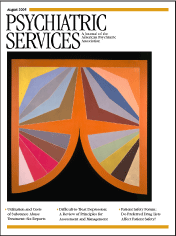Abstract
OBJECTIVE: This study examined data from the first 1,500 patients with major depressive disorder who were entered into the Sequenced Treatment Alternatives to Relieve Depression (STAR*D) and compared baseline characteristics of outpatients on the basis of their insurance status. METHODS: We compared the demographic and clinical characteristics and the features of the presenting symptoms of outpatients with private insurance, public insurance, Medicaid and Medicare, or no insurance who were seeking treatment for depression. RESULTS: Valid insurance data were available for 1,452 patients. Compared with patients with private insurance, patients with public or no insurance were more likely to be members of a racial or ethnic minority group, unmarried, less educated, and unemployed. Patients were more likely to attend primary care clinics if they had public insurance (46 percent) compared with private insurance (34 percent) or no insurance (30 percent). Compared with the other groups, patients with public insurance had the greatest number and severity of comorbid medical conditions. In general, compared with patients with private insurance, those with public or no insurance had greater severity of depression, more comorbid psychiatric symptoms, lower life satisfaction scores, and greater functional impairment. These findings remained after the analyses adjusted for gender, employment, comorbid medical conditions, race, and duration of illness. CONCLUSIONS: Compared with patients with private insurance, those with public or no insurance had a more chronic, more severe, and more disabling form of depression.



